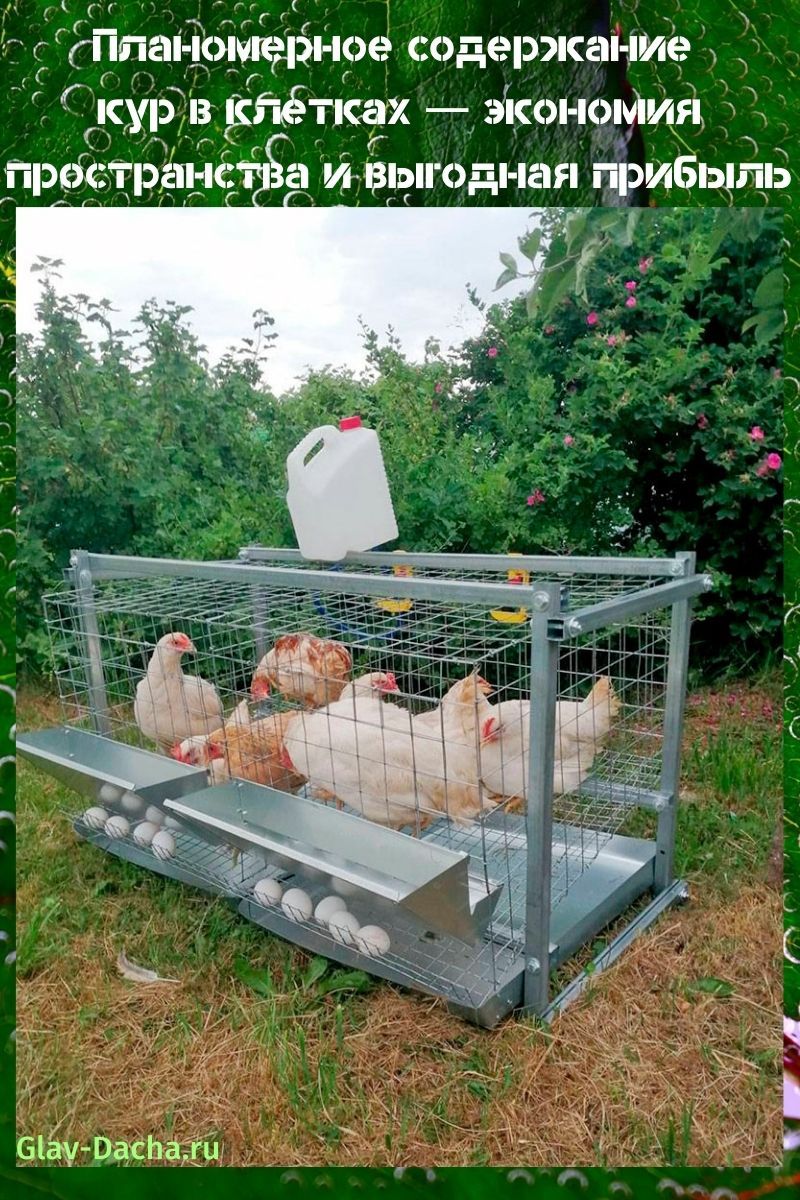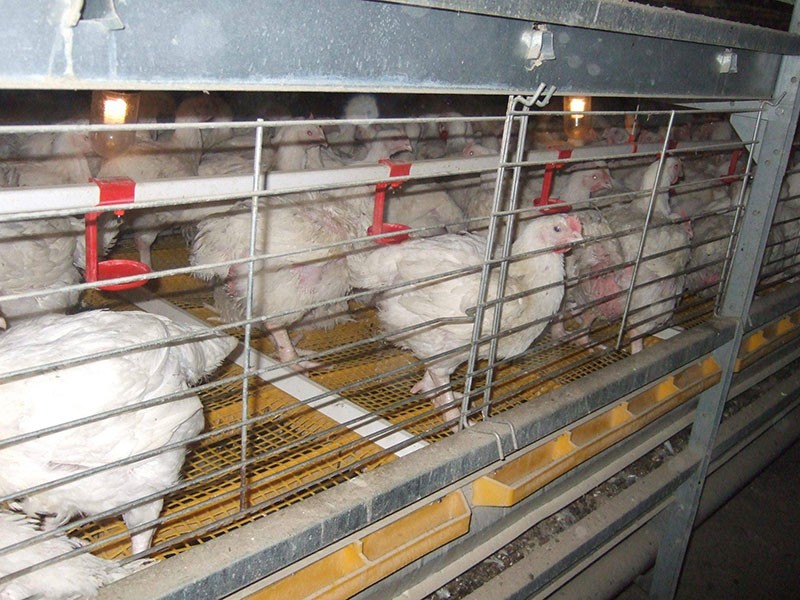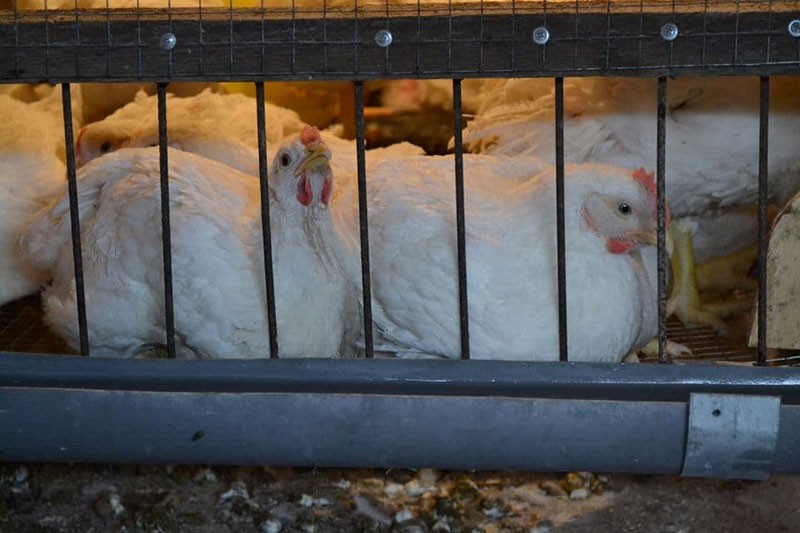Keeping chickens regularly in cages - saving space and profitable profit
 Keeping chickens in cages is the most efficient way to raise poultry. To organize it, you will not need a huge room and area for walking. Therefore, summer residents who have small plots of land are happy to raise chickens on their plots. They boldly get down to business, taking into account the recommendations of experts.
Keeping chickens in cages is the most efficient way to raise poultry. To organize it, you will not need a huge room and area for walking. Therefore, summer residents who have small plots of land are happy to raise chickens on their plots. They boldly get down to business, taking into account the recommendations of experts.
What needs to be done to competently breed chickens in cages and receive fresh eggs every day? Are there fixed parameters for lighting, temperature and humidity for the room? What breeds are suitable for cage keeping? How to properly organize bird feeding? Find out what the experts are saying.
Advantages and disadvantages of the method

This method has several advantages:
- simple care of livestock;
- efficient collection of eggs;
- reliable protection from predators;
- ergonomic feeding;
- the ability to increase the number of birds in a limited space (10 individuals can fit 1 m²).
 However, keeping chickens in cages has several disadvantages.
However, keeping chickens in cages has several disadvantages.
A sedentary lifestyle can cause heart attacks in birds, even with a large amount of food. The degree of egg production sometimes decreases.
In addition, they form:
- deformation of the legs;
- rickets;
- avitaminosis;
- prolapse of the oviduct;
- cannibalism.
 Besides, artificial lighting requires additional material investments. Since birds are left without walking, trace elements are added to the diet. After all, "free" they feed on grass and insects. In addition, chickens love to nibble on small stones.
Besides, artificial lighting requires additional material investments. Since birds are left without walking, trace elements are added to the diet. After all, "free" they feed on grass and insects. In addition, chickens love to nibble on small stones.
Quality cells are the key to success
 To achieve high feathered egg production, there are a number of requirements for the design of cages. Walls and ceilings are made of steel grating to provide fresh air and ventilation for the birds. The pallet mesh is made of rods with a diameter of at least 2.5 mm. It is placed at an inclination of approximately 7 °. Thanks to this, the structure can support the weight of the livestock in one cage.
To achieve high feathered egg production, there are a number of requirements for the design of cages. Walls and ceilings are made of steel grating to provide fresh air and ventilation for the birds. The pallet mesh is made of rods with a diameter of at least 2.5 mm. It is placed at an inclination of approximately 7 °. Thanks to this, the structure can support the weight of the livestock in one cage.
The front side is constructed from rods. The width between them is about 50 mm and the height is 100 mm. It is convenient for birds to eat through these openings. Drinkers and feeders securely attached to a metal structure. However, they are made removable for regular cleaning and, if necessary, repair.
 In addition, the density of laying hens in cages should be taken into account so that they feel comfortable "in captivity". It depends on the dimensions of the structure, breed and age of the chickens. For example, 0.2 m² is sufficient for an adult. One standard cage contains from 2 to 11 individuals. If the birds used to live in a spacious chicken coop, then the required space is doubled.
In addition, the density of laying hens in cages should be taken into account so that they feel comfortable "in captivity". It depends on the dimensions of the structure, breed and age of the chickens. For example, 0.2 m² is sufficient for an adult. One standard cage contains from 2 to 11 individuals. If the birds used to live in a spacious chicken coop, then the required space is doubled.
Birds of different age categories and breeds cannot be "settled" in one section. Otherwise, conflicts will arise between them, which will affect egg production.
Arrangement of a chicken coop
 In order to keep the laying hens in cages ideal, the room is equipped with special equipment. A vacuum water supply system is created from a volumetric tank and flexible pipes.It is securely sealed with a lid and placed above all drinkers. To maintain the optimum temperature (+ 20-27 ° C) and humidity (50-70%), fans are installed in the chicken coop.
In order to keep the laying hens in cages ideal, the room is equipped with special equipment. A vacuum water supply system is created from a volumetric tank and flexible pipes.It is securely sealed with a lid and placed above all drinkers. To maintain the optimum temperature (+ 20-27 ° C) and humidity (50-70%), fans are installed in the chicken coop.
Egg production and taste of poultry meat directly depend on the amount of light. Therefore, additional lighting is carried out into the room. For business use:
- conventional incandescent lamps with a capacity of 100 W;
- energy-saving elements in the form of a spiral;
- LED lamps (12 W).
If necessary, set special timers that will adjust the lighting mode. In the presence of window openings, it is possible to save energy.
Laying hens need light for about 16 hours a day.
 In order to maintain an optimal microclimate in the hen house in winter, it is carefully insulated using foil-clad foam, foam or mineral wool. These materials wonderfully retain the heat that is generated inside the room. The bedding layer of straw, sawdust, hay and peat also helps to control the temperature.
In order to maintain an optimal microclimate in the hen house in winter, it is carefully insulated using foil-clad foam, foam or mineral wool. These materials wonderfully retain the heat that is generated inside the room. The bedding layer of straw, sawdust, hay and peat also helps to control the temperature.
Windows and doors must be air-tight to prevent drafts in the room.
Keeping chickens in cages: a scheme for novice poultry breeders
 Poultry farming is not easy. It requires certain skills and knowledge. After preparing the premises, installing cages and equipment, they begin to select a suitable breed of chickens. Today there are a huge number of them.
Poultry farming is not easy. It requires certain skills and knowledge. After preparing the premises, installing cages and equipment, they begin to select a suitable breed of chickens. Today there are a huge number of them.
Experts advise paying attention to the following options:
- Laying crosses (characterized by rapid growth, unpretentiousness, resistance to infections);

- Leghorn (brings up to 250 eggs per year);

- Hisex (require diligent care);

- Loman Brown (egg production 320 pieces per year).

Each breed of chicken has its own charms for cage keeping. Therefore, when choosing a bird, it is worth considering the size, age and diet of individuals. It is important to check their physical condition by paying attention to their eyes, plumage and beak. Chickens are delivered in lattice boxes or cages so that they can breathe fresh air freely.
Maintaining cleanliness

Successful cage rearing involves daily house cleaning. It consists of a number of activities:
- disinfection of metal structures;
- regular removal of droppings;
- replacement of water in the tank;
- cleaning of feeders and drinking bowls.
Disinfection is carried out at intervals of 1-2 days. Every 2 weeks, the cages are freed from birds and treated with lime mixed with chlorine. In addition, they closely monitor the humidity and temperature in the room. Otherwise, mold can form on the walls.
The chicken coop is regularly ventilated, in which cages with chickens are installed.
Optimal diet
 Balanced feed for poultry helps to strengthen the immune system, rapid weight gain and egg production. Breaking the rules leads to considerable problems. Chickens store an abundance of fat. They get sick more often and less often lay eggs.
Balanced feed for poultry helps to strengthen the immune system, rapid weight gain and egg production. Breaking the rules leads to considerable problems. Chickens store an abundance of fat. They get sick more often and less often lay eggs.
Therefore, the diet should include:
- vegetable and animal proteins (about 15%);
- fats - within 6%;
- minerals;
- vitamins.
Often, farmers use ready-to-use mixtures for successful cage feeding. They consist of legumes, grains, oilcakes, mineral supplements and vitamins.
If desired, the food is prepared independently from such components.:
- corn;
- meat and bone meal;
- greens;
- roots;
- peas;
- eggshell:
- worms or bloodworms.
 The mixture is distributed among the feeders, taking into account the daily dose. For adult chickens, it is about 320 g. It is given in small portions. Food debris is carefully removed. In the summertime, farmers harvest nettles, millet and clover for birds. They tie small bundles that are dried under a canopy. Boiled potatoes, beets and pumpkin are added to the winter diet. Crushed pebbles are regularly given to birds to stimulate digestion.
The mixture is distributed among the feeders, taking into account the daily dose. For adult chickens, it is about 320 g. It is given in small portions. Food debris is carefully removed. In the summertime, farmers harvest nettles, millet and clover for birds. They tie small bundles that are dried under a canopy. Boiled potatoes, beets and pumpkin are added to the winter diet. Crushed pebbles are regularly given to birds to stimulate digestion.
Drinking water should be clean and fresh.Therefore, it is advisable to change it regularly.
We take into account risk factors
 Despite the comfortable living conditions and quality care, sometimes problems arise. No living soul is immune from disease. Therefore, farmers are advised to monitor the livestock every day. Having found alarming signs, they immediately contact the veterinarian. Infected individuals are isolated from healthy chickens and receive high-quality treatment. With the help of routine vaccination, mass infection of pets is prevented. Whenever possible, special "baths" of sand and wood ash are arranged for chickens.
Despite the comfortable living conditions and quality care, sometimes problems arise. No living soul is immune from disease. Therefore, farmers are advised to monitor the livestock every day. Having found alarming signs, they immediately contact the veterinarian. Infected individuals are isolated from healthy chickens and receive high-quality treatment. With the help of routine vaccination, mass infection of pets is prevented. Whenever possible, special "baths" of sand and wood ash are arranged for chickens.
To avoid massive infection, birds should be regularly examined by a veterinarian.
In addition, it should be remembered that a number of external and internal factors affect egg production. Old and sick chickens run badly. There are beef breeds that gain weight quickly. The external environment also has a particular impact. Severe frosts (-20 ° C) or summer heat can also cause egg production decline.
Despite the risk factors, cage keeping is affordable for many novice farmers. It includes the preparation of the premises. Construction or purchase of finished cells. Choosing the right chicken breed. A balanced diet. Systematic care, keeping the coop clean and taking care of the health of the livestock. Thanks to this, fresh homemade eggs and delicious meat will appear on the table for dinner.